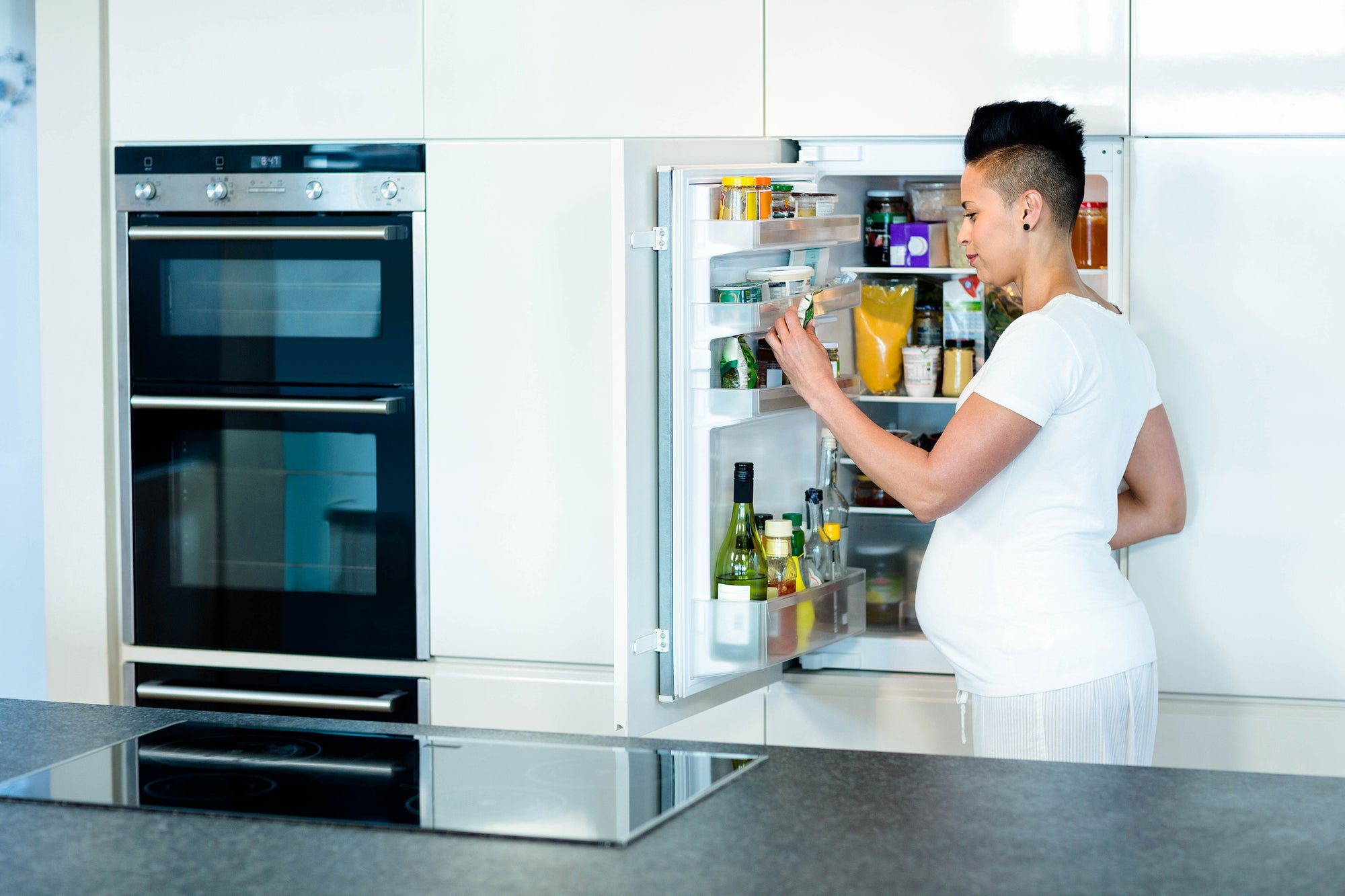Your cart is empty. Let's fix that!


Growing babies are sensitive to toxins. You probably already know that if you’re planning to conceive or are already pregnant, you need to quit smoking and avoid alcohol. But you’ll also want to minimize your exposure to harmful chemicals by using green cleaning products in your home and safe cookware and personal care products.
According to the Centers for Disease Control, exposure to even small amounts of toxins during pregnancy, infancy, childhood, or puberty can lead to diseases (1). The key is to be aware without getting overwhelmed. Once you know the most pressing risks — from mercury to phthalates in personal care products to triclosan in household cleaning products — you can learn how to mitigate them.
The list of hidden toxins can be overwhelming, but there are some common culprits. We’ve put together a list of toxic household chemicals to avoid during pregnancy and the reasons why. And we’ve compiled our best tips into a shorthand Safer Home Checklist to help you avoid toxins in your home. Made by our team of experts, this checklist can help take your worries away–so you feel truly relaxed in your home as you prepare for your baby.
You can also download a printable version of our Safer Home Checklist so you know what to avoid when you’re expecting.
✔ Drink filtered water. Make sure to drink plenty of water. Water helps flush toxins out of your system and keeps your amniotic fluid at healthy levels. Purify your tap water with a filter. Water filter pitchers are inexpensive and filter out toxins such as heavy metals, chlorine, and pesticides (2).
✔ Limit canned foods: The toxic plasticizer BPA has been removed from most can linings due to consumer pressure. But the replacements are related chemicals that may not be much safer. Eat more fresh and frozen foods and limit your use of canned goods (3).
✔ Use safe cookware and food storage containers: Avoid non-stick cookware like Teflon®. Choose safer options such as cast iron, stainless steel, ceramic, and glass. Don’t put plastic in the microwave or dishwasher, even if it says “microwave-safe.” And refrain from storing or buying food in plastic (4). Here’s why:
✔ Use green personal care and cleaning products: One common question is whether it’s safe to use cleaning products during pregnancy. For good reason. Personal care products can also be hiding places for toxins. Check labels, and avoid parabens, triclosan, and phthalates, which often show up as “fragrance.” Consider making your own green cleaning products. When it comes to choosing safe cleaning and personal care products during pregnancy, here’s what to watch out for:
✔ Avoid pesticides in your home and yard: Don’t apply pesticides or herbicides in your home or garden. If you rent, ask your landlord not to spray inside or out.
✔ Delegate cleaning the litter box: Cat feces can contain a parasite called toxoplasma that poses a risk to pregnant women. If there are no other adults in the household, wear gloves and a mask when you change the litter.
✔ Redecorate consciously: New furniture, carpets, and mattresses are typically loaded with hormone-disrupting chemicals that sometimes take years to off-gas. Preconception and pregnancy is not the time to bring that stuff into your home.
✔ Skip the remodel too: Remodeling often involves paint, vinyl, finishes, and other toxic substances. Unless you can do it completely non-toxically, let it be for now. Here’s why:
✔ Be careful what you bring into the home. There are many household items or conveniences so common you might not consider them when thinking of chemicals to avoid when pregnant. Don’t use mercury-containing compact fluorescent light bulbs, skip the dry cleaner, and say no to chemical flea collars and shampoos.
The saying goes that the best defense is a strong offense and while chemical toxins are something to address head on, it’s always a good idea to look after your overall health and that of your growing baby. It’s not only your environment that needs a little extra attention and preparation for this new life stage. Eat well, stay hydrated, get exercise and the rest you need to stay healthy and well. Prenatal vitamins can help prepare you and your baby and supplement the important nutrients you need.
We are constantly exposed to hidden toxins in and around our homes, from the way we store and prepare our food, to the personal care and cleaning products we use, to the everyday items whose fumes we breathe. In fact, according to the Environmental Protection Agency, the air inside your home is likely two to five times more polluted than the air outside its walls (21). With your growing baby so sensitive to these toxins, now is the time to remove what you can from your environment — and it’s a good idea to keep these habits going for a fresher, cleaner, safer home once baby arrives. Your whole family will appreciate the difference.
The good news is that with a few simple steps, you can dramatically limit your exposure to hidden household toxins.
(1) Planning for pregnancy. Centers for Disease Control. Reviewed 2020 April 16. https://www.cdc.gov/preconception/planning.html
(2) Drinking water from the tap vs. Brita: Are water filters actually better? Healthline.com. 2019 June 21. https://www.healthline.com/health/home/water-filter-pitcher
(3) Canned foods: why it matters. Center for Environmental Health. 2020. https://ceh.org/products/canned-foods/
(4) Pots, pans, and plastics: A shopper’s guide to food safety. WebMD. 2008. Dec.19. https://www.webmd.com/food-recipes/features/cookware-plastics-shoppers-guide-to-food-safety
(5) BPA Update: tracking the canned food phaseout. Environmental Working Group. 2020 Nov. https://www.ewg.org/news-insights/news/bpa-update-tracking-canned-food-phaseout
(6) The problem with plastic that’s leaching into your food. Vox. Updated 2018 Dec.4. https://www.vox.com/science-and-health/2018/9/11/17614540/plastic-food-containers-contamination-health-risks
(7) Is nonstick Teflon safe? Healthline. 2017 Jul. 13. https://www.healthline.com/nutrition/nonstick-cookware-safety
(8) Should people be concerned about parabens in beauty products? Scientific American. 2014 Oct. 6. https://www.scientificamerican.com/article/should-people-be-concerned-about-parabens-in-beauty-products/
(9) What are phthalates? WebMD. 2016 Aug. 15. https://www.webmd.com/a-to-z-guides/features/what-are-phthalates
(10) The effects of triclosan on puberty and thyroid hormones in male Wistar rats. Toxicol Sci. 2009 Jan;107(1):56-64. https://pubmed.ncbi.nlm.nih.gov/18940961/
(11) Ethylene glycol and propylene glycol ethers - Reproductive and developmental toxicity. Med Pr. 2015;66(5):725-37. https://pubmed.ncbi.nlm.nih.gov/26647990/
(12) Pesticides and pregnancy. American Pregnancy Association. 2017 May. https://americanpregnancy.org/healthy-pregnancy/is-it-safe/pesticides-during-pregnancy/
(13) Parasites: Toxoplasmosis. Centers for Disease Control and Prevention. 2018 Sep. 18. https://www.cdc.gov/parasites/toxoplasmosis/gen_info/index.html
(14) What are volatile organic compounds? Environmental Protection Agency. 2019 Aug.1. https://www.epa.gov/indoor-air-quality-iaq/what-are-volatile-organic-compounds-vocs
(15) Brominated flame retardants: a novel class of developmental neurotoxicants in our environment? Environ Health Perspect. 2001 Sep;109(9):903-8. https://pubmed.ncbi.nlm.nih.gov/11673118/
(16) Pollution risk of CFL bulbs studied. UPI. 2011 July 6. https://www.upi.com/Science_News/2011/07/06/Pollution-risk-of-CFL-bulbs-studied/89001309987703/
(17) Dry cleaning chemicals hang around- on your clothes. Environmental Working Group. 2011 Sep. 12. https://www.ewg.org/news-insights/news/dry-cleaning-chemicals-hang-around-your-clothes
(18) Toluene. Environmental Protection Agency. Accessed 2021 October. https://www.epa.gov/sites/default/files/2016-09/documents/toluene.pdf
(19) IARC classifies radiofrequency electromagnetic fields as possibly carcinogenic to humans. World Health Organization: International Agency for Research on Cancer. 2011 May 31. https://www.iarc.who.int/wp-content/uploads/2018/07/pr208_E.pdf
(20) Poison on Pets II: Toxic Chemicals in Flea and Tick Collars. National Resources Defense Council. 2009 April 23. https://www.nrdc.org/resources/poison-pets-ii-toxic-chemicals-flea-and-tick-collars
(21) Indoor air quality. United States Environmental Protection Agency. Updated 2018 July 16. https://www.epa.gov/report-environment/indoor-air-quality